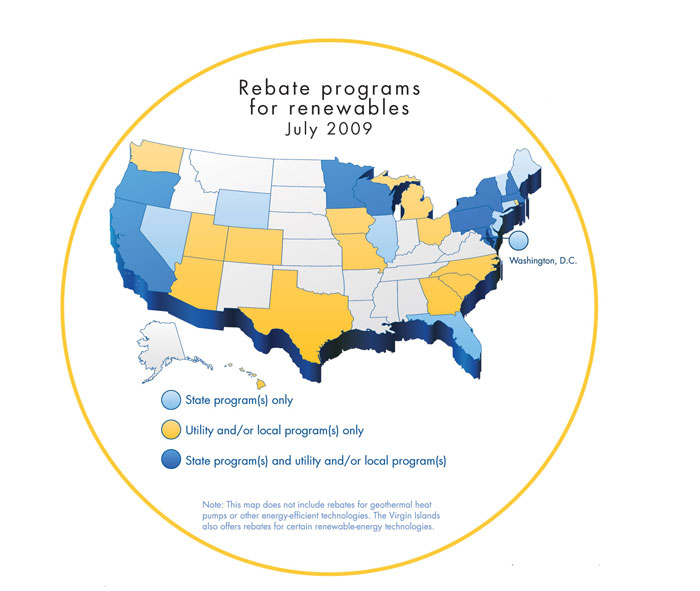The first small photovoltaic (PV) predecessors to PV systems currently being installed on roofs were introduced during the early 1970s. Many of these systems were installed with little thought or planning; consequently, those who purchased the systems were disappointed, government incentives were discontinued and PV quickly fell out of public favor.
However, with energy costs constantly in flux, the recent extension of federal tax incentives and an overall trend toward environmental friendliness, more reliable PV products have been introduced and more building owners are looking at rooftop PV systems as a viable way to reduce energy costs.
We all have heard about "big box" building owners installing 50-kilowatt (kW), 100-kW and utility-sized PV systems on roof systems larger than 50,000 square feet. However, I believe PV roof system installations' future lies with small businesses and the residential sector where 1- to 25-kW systems will be installed on roof systems smaller than 50,000 square feet.
If you are interested in installing practical and efficient PV roof systems, there are numerous factors you must consider before and during each installation.
PV basics
PV systems are rated based on the amount of electricity they produce at maximum output, which is expressed in watts. A 1-kW system will produce 1,000 watts of power at peak output. Likewise, a 25-kW system will produce 25,000 watts at peak output.
Production of 1 kW for one hour is 1 kilowatt-hour (kWh). In theory, a 25-kW system producing at maximum output for one hour will produce 25 kWh. However, PV systems never produce at the tested maximum wattage; line losses of about 5 percent in the wiring and inverter, as well as imperfect sunlight exposure, reduce the actual working watts produced.
PV system components
A PV system comprises various components, including PV modules, inverters and associated hardware.
PV modules (or PV panels, as they commonly are called) produce electricity directly from the sun. They are solid-state devices with no moving parts and require little maintenance. Two panel types typically are used for rooftop PV applications: crystalline silicon panels and amorphous silicon panels with various mineral compositions.
Crystalline silicon panels are used most often and consist of a rigid frame and glass module typically installed on a supporting rack. These panels have a higher output at 14 to 20 watts per square foot. Amorphous silicon panels are lower in output at 5 to 10 watts per square foot, but they produce electricity in lower light conditions. Thin-film panels are available on a rigid frame, but most are flexible and can be formed into various shapes and integrated into roof membranes.
A PV system's inverter converts direct current (DC) produced by the panels to alternating current. For a majority of applications, the produced electricity is tied directly into the utility grid. When the panels are producing, the inverter determines how much current the facility needs and sends the rest to the grid. When the panels are not producing, the inverter switches off and current from the grid is sent to the facility. If storing electricity is desired, the system requires batteries.
As with any electrical system, PV systems require some associated hardware—such as wiring and disconnects—to deliver electricity and provide circuit protection. With system voltages approaching 600 volts DC, these components must be sized correctly.
Size issues
Before installing a PV system, you must consider several factors, including the system's size. When determining a PV system's size, consider the building owner's goals and available budget, roof area available to accommodate the PV system and building location.
Building owners' goals may include supplementing the cost of electricity by producing some (or all) of the building's needed electricity, becoming more environmentally friendly or lessening future energy costs.
A roof's available space is a primary factor when determining a PV system's size. Depending on the panel type and installation specifics, outputs range from 5 to 18 watts per square foot. Crystalline silicon panels tend to have the highest output per square foot while amorphous silicon panels tend to have lower output per square foot. Fewer crystalline silicon panels are required than amorphous silicon panels to produce the same amount of electricity.
Although the maximum output per square foot of amorphous silicon panels is lower, these panels are able to produce power in lower light conditions than crystalline silicon panels. Watt for watt, during one year of production, amorphous silicon panels produce more electricity than crystalline silicon panels. A drawback is amorphous silicon panels require about twice the space because of their lower efficiency.
If a rooftop has space limitations, crystalline silicon panels may be the better option. If enough space is available to install the same wattage, amorphous silicon panels likely are the most efficient option.
Another major factor to consider when determining a PV system's size is where the system will be installed. A 10-kW PV system installed in Iowa, for example, will have about 60 percent of the output of a 10-kW PV system installed in Arizona. This is a condition not only of latitude but also of available full and partial sun days.
Location also is a factor in determining at what angle panels must be installed to produce the most electricity. Because of the sun's higher angle in southern states, installing PV panels flat on a roof minimally will affect power output whereas in the northern states where winter sun angles are low, winter output greatly will be affected.
The pre-installation process should include analyzing available sunlight at the building's location. There are several devices that can help you map possible shading at a particular site. The most common device—a solar pathfinder—provides solar mapping of a site during a 12-month period and considers the site's latitude.
It is critical that a site not just be "eyeballed"; available devices can pick out shading the naked eye cannot. If shading is excessive, the site may be inappropriate or the system's size may need to be adjusted to accommodate the shading.
If a building's location is appropriate, a complete energy audit of the facility will prove beneficial, focusing on ways to reduce energy consumption and looking at all aspects of electrical use. The audit may be able to identify areas where energy consumption can be reduced significantly so a smaller PV system could be installed.
For example, it may be more cost-effective to replace lighting with more efficient bulbs than to size a PV system to meet the needs of the inefficient bulbs. A review of past energy consumption on an annual basis provides energy use trends and can help determine annual electricity needs. The system's size then can be based on the kWh a system produces during one year.
After a PV system's size is determined, the system's details can be formulated. These details include the roof's condition and restoration, PV panel type and how the system will be mounted.
PV system details
PV panels have a projected service life of 25 to 30 years when mounted on a roof. However, a roof system's age and condition play major roles in a PV project's scope and cost. A thorough roof evaluation will determine whether the PV installation project also should incorporate roof replacement or repairs. Even if the roof appears to be in good condition, construction traffic during PV installation will stress the roof and possibly cause damage that may not be immediately observed. Considering that roof systems rarely last more than 30 years, you may not be able to install PV systems on roofs that are 15, 10 or even five years old.
A roof's color also plays a role in PV panel output depending on the type of panel used. Crystalline silicon panels lose 0.3 to 0.5 percent efficiency for every two degrees above 77 F. Amorphous silicon panels are not as severely affected by temperature and maintain a fairly consistent production level throughout a wide ambient temperature range. If an existing dark roof system is to be used, panel selection and sizing may be affected. If the roof system is going to be replaced, a highly reflective, low-emissivity roof should be considered.
The panel type determines how it should be mounted to a given roof system. Crystalline silicon panels have rigid frames and require a rack for support. The rack may be secured to a building's structure through the roof, requiring roof penetration, or by installing a ballasted rack system.
Before any PV system type is installed on a roof, a structural evaluation is required (particularly when a ballasted rack is used). Any type of rack-mounted system also must be sized for wind loads that will be placed on it.
Flexible amorphous silicon panels do not require a separate mounting system because they typically are laminated, welded or adhered directly to roof membranes. Because thin-film panels are lighter, the structural and wind loads placed on roof systems are diminished.
Although there has not been extensive testing, local fire officials should be contacted before installing PV systems.
Cost and payment
Finances may be a limiting factor when installing a PV roof system. Although PV systems' costs are decreasing (current costs are about $7.50 per watt), they still are expensive. Federal incentives available for commercial businesses include a 30 percent rebate on a system's cost and five-year depreciation with 60 percent bonus depreciation during the first year. Several states also have additional incentives that bring the cost down to a level where the building owner will see a payback for the PV installation in less than five years (See figure).

A geographic overview of states' rebate programs for renewable energy improvements to buildings provided by the Database of State Incentives for Renewables & Efficiency
Reimbursement of power sent to the utility grid for smaller systems usually is by net metering, a simple process in which a facility purchases power when the meter spins one direction. When selling power, the meter spins the opposite direction. At the end of the month, there either is a charge from the utility company for power consumed or a credit for power sold. There are many variations regarding how electricity is paid for aside from net metering, including power purchase agreements, avoided cost and lease backs. These types of agreements typically are associated with systems larger than 50 kW.
PV's future
With renewed interest in PV roof systems and available financial incentives, as well as performance improvements and single-sourcing components, homeowners and small-business owners may be looking to PV as a means to reduce energy costs.
To avoid repeating past mistakes, PV systems must live up to purchasers' expectations. Thoroughly understanding the factors that make a PV roof system successful will ensure PV installations continue to become more mainstream.
Kevin Ernster, RRC, is a senior consultant at Benchmark Inc., Cedar Rapids, Iowa.



